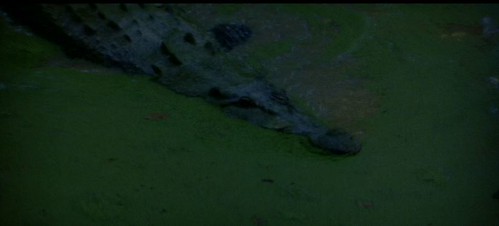I thought I'd bump this to the top of the queue. It's a review of a war picture, one where the scenes of war are intercut with scenes of animal and plant life. For those animals, the carnage of war is just an odd form of bad weather. It affects them; they have to deal with it; but it's not about them. What's the COVID-19 pandemic to nonhuman life on earth?
I’d never seen a Terrence Malick film when I went to see Tree of Life, so I had little idea what to expect. I’ve just watched The Thin Red Line (on a crappy Netflix DVD that skipped). The style was instantly recognizable. Well, not an instant. But only minutes.
It wasn’t the croc’s slow and elegiac slipping into the water (c. 30 seconds):
But this, the light streaming through the trees from above:
And the voice-over, meditating: “What’s this war, in the heart of nature? Why does nature vie with itself? The land contend with the sea?” Then the light voices (children’s choir?) on the sound track.
That’s him! I was thinking. That’s the guy.
The kids, intent:
The up-ward-looking underwater shots:
Yep, it’s him. We’re only three minutes into the film and Malick’s established his style, firmly. At least it’s the style I infer to be his from having seen only two films, this and Tree of Life.
Now, I’m beginning to understand Tree of Life. Better. Just one other film by the same man tells me so much more about that first one I saw. Because it gives me a sense of what’s central to his vision, and what’s incidental.
But I’m not going to try to work out all of that, not now in this little post. All I’m after is the first tentative registration of an understanding.
You see, The Thin Red Line is a war picture, about a really bloody WWII battle at Guadalcanal. That’s an extraordinary opening for such a picture. Yeah, the croc, he’s ugly. But not rendered as such, not the violence. Just the cool slipping into the water, silently, with grace even.
Where’s the blood? I was wondering. The gunfire, the bombs, the screams of dying men?
It came, it came. But always next to elegy. Always.
What’s that about? Well, maybe that the world ISN’T ABOUT US. We’re in it, yes, and we’re consumed by our role in it, can hardly see anything but our role.
Yet, it isn’t about us, the earth, the galaxy, the cosmos. Compared to these two Malick films every other film I’ve seen looks like it’s about US. Except for Fantasia. Isn’t that a kick, that Terrence Malick should indirectly point up the genius of that Disney cartoon?
Our stories happen IN the world and ON the earth. And Malick tells those stories. They have more screen time than the OTHER story. But the other story is always, strongly, there.
The universe.
Not about us.
Free.
Free at last!










